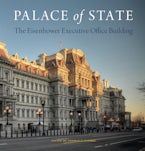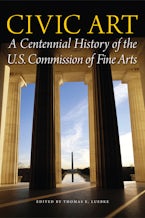- Home
- Palace of State

Palace of State
The Eisenhower Executive Office Building
Edited by Thomas E. Luebke
Published by: U.S. Commission of Fine Arts
272 Pages, 11.00 x 11.00 x 1.20 in, 272 color illus., 208 b&w illus.
Other Retailers:
Towering over the White House, the colossal granite Dwight D. Eisenhower Executive Office Building (EEOB) was first constructed to house the departments of State, War, and Navy in the nineteenth century, and it now serves as the home of the Executive Office of the President. Having outlasted decades of plans threatening alteration or outright demolition, the building survives as one of the foremost examples of Second Empire design in the United States.
Palace of State details the building's rich architectural and historical legacy—from the beginnings of federal civic architecture in Washington to its construction as the world's largest office building after the Civil War, and culminating in the recently completed restoration process that began in the 1980s. Featuring beautifully rendered architectural drawings, historic images, and lush contemporary photography, this illustrated history presents a comprehensive study of an iconic landmark that continues to serve in its role as a monumental setting for statecraft.
Palace of State details the building's rich architectural and historical legacy—from the beginnings of federal civic architecture in Washington to its construction as the world's largest office building after the Civil War, and culminating in the recently completed restoration process that began in the 1980s. Featuring beautifully rendered architectural drawings, historic images, and lush contemporary photography, this illustrated history presents a comprehensive study of an iconic landmark that continues to serve in its role as a monumental setting for statecraft.
Thomas E. Luebke has served as secretary to the U.S. Commission of Fine Arts since 2005.
"Palace of State is noteworthy on several counts. It offers abundant new information on a key work of 19th-century public architecture in the US—a building that is well known but previously scantily examined. The book also offers extensive context on the great surge of ambitious public building construction during the Gilded Age . . . An exceptional resource for those interested in public and/or 19th-century US architecture."—CHOICE
"A splendidly illustrated volume dedicated to what Baedeker's 1899 guide to Washington, D.C., describes as 'the building that accommodates the State, War, and Navy Departments, a huge parallelogram, enclosing two courts and measuring 567 ft. in length by 342 ft. in breadth' . . . [This is] a paper tribute to a monument hewn of sturdy American granite."—Washington Times











